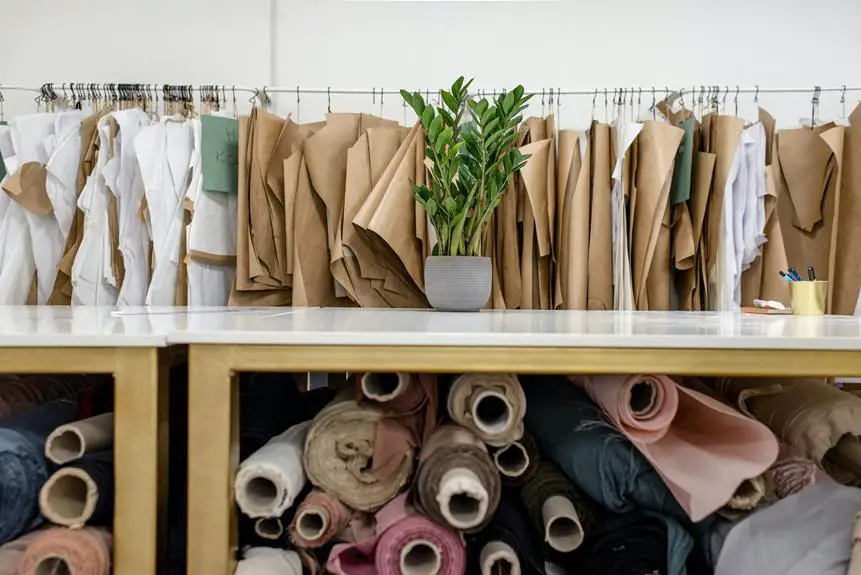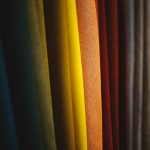You might be torn between taffeta and satin for your next project, but fear not – we're here to help you make an informed decision.
Both fabrics have their merits, but when it comes to the ultimate choice, it's all about understanding their unique properties and how they align with your needs.
From durability to versatility in garment making, we'll delve into the key factors that will guide you towards the perfect fabric for your masterpiece.
So, let's explore the intricate world of taffeta and satin, and equip you with the mastery to confidently select the ideal fabric for your next endeavor.
Key Takeaways
- Taffeta fabric has a smooth texture with a crisp, rustling sound, while satin fabric has a smooth texture that feels soft against the skin.
- Satin fabric has a lustrous appearance and reflects light beautifully, while taffeta fabric has a subtle sheen.
- Taffeta fabric is suitable for structured designs and can hold shape, while satin fabric is lighter and flows more freely, ideal for softer silhouettes.
- Satin fabric is more durable than taffeta due to its tightly woven structure and is suitable for formal wear, upholstery, and linings.
Properties of Taffeta Fabric
Taffeta fabric has a smooth texture and a crisp, rustling sound when touched, making it a popular choice for elegant and structured garments. The smooth texture of taffeta is a result of its tightly woven, fine threads, which create a distinctive lustrous sheen on the surface. This lustrous sheen gives taffeta a luxurious and opulent appearance, making it highly sought after for formal wear and couture fashion.
The smoothness of taffeta fabric not only contributes to its visual appeal but also enhances its tactile quality. When running your fingers over taffeta, you can feel its sleek and polished surface, adding to the overall sensory experience. This tactile sensation, combined with the fabric's characteristic rustling sound, creates a sense of luxury and sophistication that's unmatched by many other textiles.
The smooth texture and lustrous sheen of taffeta also make it a versatile choice for a wide range of garments, including evening gowns, bridal wear, and tailored suits. Its ability to hold its shape and create structured silhouettes further adds to its allure, making taffeta a timeless favorite among fashion designers and discerning individuals alike.
Properties of Satin Fabric
When choosing between taffeta fabric and satin, you'll find that satin fabric is known for its smooth and glossy surface, making it a popular choice for luxurious and glamorous garments. Satin fabric possesses exceptional properties that set it apart from other materials:
- Smooth Texture: Satin fabric is celebrated for its smooth texture, which feels incredibly soft against the skin and adds a touch of elegance to any garment.
- Lustrous Appearance: The lustrous sheen of satin fabric reflects light beautifully, giving the material a luxurious and opulent appearance that's perfect for formal wear.
- Luxurious Drape: Satin fabric drapes exquisitely, creating graceful and flowing silhouettes that enhance the overall look of the garment.
- Silky Feel: The silky feel of satin fabric adds a sensual and indulgent dimension to clothing, making it a top choice for special occasions and high-end fashion pieces.
- Versatile Usage: Satin fabric's versatility allows it to be used for a wide range of garments, from evening gowns and bridal wear to lingerie and accessories, making it a staple in the fashion industry.
These exceptional properties make satin fabric an ultimate choice for those seeking to create garments with an air of sophistication and luxury.
Durability Comparison
Considering the durability of fabrics, you'll find that satin fabric outlasts taffeta due to its tightly woven structure and resistance to wear and tear. Satin is known for its exceptional durability, making it a preferred choice for items that require longevity. Its tightly woven fabric and smooth surface make it less prone to snags and tears compared to taffeta. The strength of satin fabric lies in its weave, which consists of floating warp yarns on the surface, giving it a lustrous appearance while also enhancing its durability.
In terms of fabric strength, satin's tightly woven structure provides a high level of resistance to stretching, creasing, and tearing, ensuring that it maintains its original form and appearance over time. This durability makes satin fabric suitable for various applications, including formal wear, upholstery, and linings for luxury items.
In contrast, taffeta, while also a strong fabric, isn't as durable as satin due to its less tightly woven construction. When considering durability and long-term use, satin proves to be the superior choice between the two fabrics.
Versatility in Garment Making
When it comes to garment making, versatility is key. The fabric's drape and texture can greatly impact the overall look and feel of a garment.
Understanding the differences between taffeta and satin in terms of fabric drape and texture preferences is essential for making the ultimate choice.
Fabric Drape Differences
Choose a fabric with the right drape for your garment by understanding the differences between taffeta and satin. Fabric drape is crucial in garment making, as it affects how the fabric hangs and flows, ultimately influencing the overall look of the garment.
When comparing taffeta and satin, consider the following:
- Fabric Weight: Taffeta is typically crisper and stiffer, making it more suitable for structured designs, while satin is lighter and flows more freely, lending itself well to softer, more fluid silhouettes.
- Sheen Level: Taffeta has a subtle sheen that catches the light beautifully, adding an elegant touch to garments, whereas satin boasts a higher sheen, giving off a luxurious, glossy appearance.
Understanding these differences will enable you to make an informed decision when choosing between taffeta and satin for your garment.
Garment Texture Preferences
To achieve versatile garment textures, experiment with combining taffeta and satin to create dynamic visual and tactile experiences. By blending the luxurious smoothness of satin with the crisp, structured feel of taffeta, you can achieve a sensory experience that is both visually and tactilely appealing. This innovative approach allows for the creation of garments that not only look stunning but also offer a unique textural dimension that aligns with current fashion trends. To illustrate the potential of this combination, consider the following table:
| Garment | Texture Description |
|---|---|
| Evening gown | Smooth and lustrous with a hint of crispness |
| Cocktail dress | Structured yet silky to the touch |
| Blouse | Luxurious and visually striking |
| Skirt | Texturally dynamic and on-trend |
Care and Maintenance
When it comes to keeping your taffeta fabric or satin garments looking their best, knowing the proper care and maintenance techniques is crucial.
From washing and drying to mastering stain removal, understanding how to care for these delicate fabrics will ensure their longevity.
Let's explore the best practices for maintaining the beauty and quality of taffeta and satin.
Washing and Drying
For washing and drying taffeta or satin fabric, follow the specific care instructions on the garment's label to ensure longevity and prevent damage. When it comes to delicate fabrics like taffeta and satin, proper washing and drying techniques are crucial for maintaining their quality. Here are some essential tips to keep in mind:
- Hand washing: Gentle hand washing is often the best method for these delicate fabrics.
- Delicate cycle: If using a washing machine, select the delicate cycle to minimize agitation.
- Air drying: Avoid using the dryer and instead opt for air drying to prevent shrinkage and damage.
- Fabric care: Use a mild detergent specifically designed for delicate fabrics.
- Stain removal: Address stains promptly with gentle spot cleaning methods to prevent setting.
Following these care and maintenance practices will help preserve the beauty and integrity of your taffeta and satin garments.
Stain Removal Techniques
You can effectively remove stains from taffeta or satin fabric by addressing them promptly with gentle spot cleaning methods to prevent setting and maintain the fabric's quality. When dealing with stains on these delicate fabrics, it's crucial to opt for gentle washing and chemical-free stain removal techniques.
Begin by blotting the stained area with a clean, white cloth to absorb as much of the spill as possible. Avoid rubbing the fabric, as this can spread the stain and damage the fibers.
For oily stains, sprinkle cornstarch or talcum powder on the affected area and let it sit for a few hours to absorb the oil. Then gently brush off the powder and proceed with spot cleaning using a mild detergent and cool water.
Always air dry the fabric to prevent heat damage. By following these gentle and chemical-free stain removal techniques, you can effectively maintain the pristine appearance and quality of your taffeta or satin fabric.
Pricing and Affordability
Looking for an affordable option between taffeta fabric and satin? When it comes to pricing and affordability, it's essential to weigh your options carefully. Both taffeta and satin offer budget-friendly choices, but there are a few key differences to consider.
Here's what you need to know:
- Cost Comparison: Taffeta fabric is generally more budget-friendly than satin, making it an attractive option for those looking to save on costs.
- Durability: While satin may have a higher upfront cost, its durability could potentially save you money in the long run, as it may require less frequent replacement.
- Variety: Consider the range of prices within each fabric type. Both taffeta and satin come in various grades and qualities, each with its own price point.
- Specialized Finishes: Certain finishes or treatments may affect the cost of taffeta and satin fabrics. Be sure to factor in any additional expenses for specialized options.
- Overall Value: Evaluate the overall value of your purchase. Consider factors such as fabric weight, sheen, and intended use to determine the best investment for your needs.
When making your decision, consider both the upfront costs and long-term value of taffeta fabric and satin to ensure that you make the most cost-effective choice for your project.
Conclusion: Making the Right Choice
To make the right choice between taffeta fabric and satin, assess your specific needs and preferences. Consider the event or occasion for which you need the fabric, as well as your personal style and comfort. Making decisions based on fabric aesthetics is crucial, as both taffeta and satin have their own unique visual appeal. While taffeta offers a crisp, structured look with a slight sheen, satin provides a smooth, luxurious finish with a high shine. Understanding the differences in how these fabrics drape and reflect light will help you determine which fabric aligns with your desired aesthetic. Additionally, take into account the climate and environment where the garment will be worn, as taffeta and satin may behave differently in varying conditions. By carefully considering these factors, you can make an informed decision that ensures the fabric you choose not only meets your needs but also enhances the overall look and feel of your attire.
| Criteria | Taffeta Fabric | Satin |
|---|---|---|
| Visual Appearance | Crisp, structured, slight sheen | Smooth, luxurious, high shine |
| Draping & Light | Holds shape, reflects light differently | Drapes elegantly, reflects light beautifully |
| Climate & Environment | Sturdy, may be warm | Breathable, may be cooler |
| Personal Preference | Preference for structured look and subtle sheen | Preference for smooth feel and high shine |
Frequently Asked Questions
What Are the Environmental Impacts of Producing Taffeta Fabric Versus Satin Fabric?
When considering the environmental impact of producing taffeta fabric versus satin fabric, it's crucial to analyze the production process, material sourcing, and sustainability. These factors influence the overall ecological footprint of each fabric type.
Are There Any Cultural or Historical Significance Associated With Taffeta or Satin Fabric?
Explore the rich cultural significance of taffeta and satin fabric. Their historical significance is deeply woven into art, fashion, and traditions. Understanding these connections can enhance your appreciation of these luxurious textiles and their place in society.
Can Taffeta or Satin Fabric Be Used for Home Decor and Upholstery?
For home decor and upholstery, both taffeta fabric and satin fabric offer versatility. Taffeta's crisp texture and durability make it suitable for upholstery, while satin's sheen and smooth surface add elegance to interior design.
Are There Any Specific Dyeing or Printing Techniques That Work Better on Taffeta or Satin Fabric?
When dyeing or printing on taffeta or satin, consider the fabric's weave and texture. Taffeta's crispness suits bold prints and intense dyes. Satin's smooth surface enhances delicate designs and subtle color variations. Experiment to find the best technique for each fabric.
How Do Taffeta and Satin Fabric Compare in Terms of Breathability and Comfort for Clothing?
When it comes to breathability and comfort for clothing, taffeta offers better breathability due to its crisp texture, while satin provides a luxurious feel and is more durable. Both fabrics are versatile and require low maintenance.
- How Does Ring Spun Cotton Affect Garment Fit and Shape Retention? - August 13, 2024
- What Are the Challenges in Producing Ring Spun Cotton? - August 13, 2024
- Is Ring Spun Cotton Suitable for Plus-Size Clothing? - August 13, 2024







